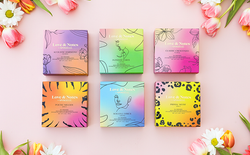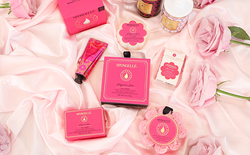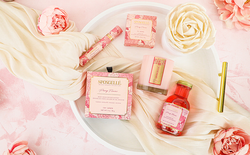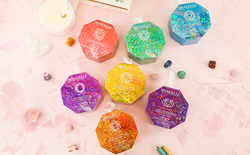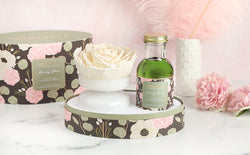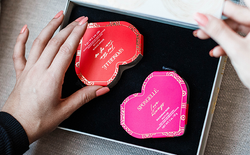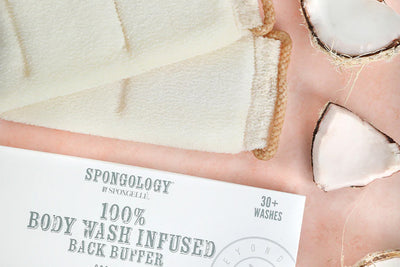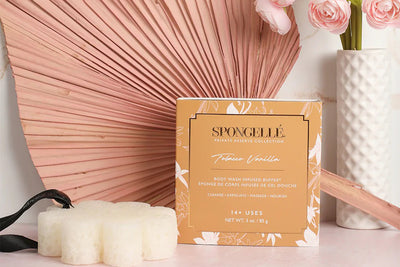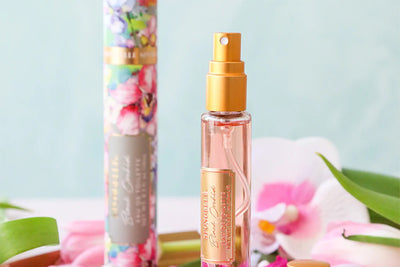Fragrance is incredibly personal. We often associate it with specific core memories, time, places, or people, which is exactly why it can evoke emotional responses.
For example, the scent of honey blossoms and jasmine may bring fond memories of playing outdoors in the spring. Cinnamon and pumpkin might remind you of spending quality time with family during the holidays, and cedarwood may leave you reminiscing about the good ol’ days when you used to go camping with dad.
In a sense, choosing a perfume is not just choosing a scent — you’re also choosing how others will remember you. With this in mind, picking a personal scent can feel a bit daunting.
To make matters worse, there are a ton of options that can put you in a tizzy if you don’t know how to differentiate between them. Take eau de toilette and eau de parfum, for instance — were you aware that these are two different things? Not to worry; Spongellé is here to help.
In this post, we’re diving into the world of perfume to uncover the differences between eau de toilette and eau de parfum. If you’re on a mission to find a personal scent, start here.
Here’s What You Need To Know About Eau de Parfum and Eau de Toilette
The French phrases “eau de toilette” and “eau de parfum” are often used interchangeably, likely due to the fact that not many of us know what sets them apart. Despite this, the two categories of fragrance are not the same.
Simply put, the difference between eau de parfum and eau de toilette boils down to the formula's fragrance concentration. Basically, an eau de parfum is a stronger scent than an eau de toilette because its concentration of oils is higher.
That said, there are actually five different types of perfume:
- Parfum: In English, this is usually called “perfume,” or sometimes “perfume extract.” This is a top-quality fragrance, with ingredients making up to 40% of the formula. That means it’s super long-lasting and undoubtedly noticeable — especially when giving someone a great big hug.
- Eau de Parfum: Next up is eau de parfum, which contains between 15 and 20% of oil concentration. On average, you can get a good six to eight hours of fragrance after spritzing yourself with this type of perfume. It does have a higher concentration of alcohol than its cousin parfum, though, so if you have sensitive skin, keep that in mind!
- Eau de Toilette: Known for its deliciously light and airy scents, eau de toilette usually contains around 15% of fragrance oil, which typically lasts between three and six hours.
- Eau de Cologne: This is usually just called “cologne” and contains a much lower fragrance concentration (about two to four percent) than its counterparts, as well as a higher alcohol content. So if your skin is extra sensitive to alcohol, you may want to steer clear of cologne and opt for a gentle eau de toilette or parfum instead.
- Eau Fraiche: Finally, we have eau fraiche, which is the lightest concentration of fragrance with an oil concentration of one to three percent. The French term “eau fraiche” translates to “fresh water.” It doesn’t last very long on the skin, but it’s a good option for those looking for a barely-there scent.
Do Eau de Parfums and Eau de Toilettes Smell Similarly?
Since eau de parfums have a higher concentration of oils, their fragrance will be stronger. As for the overall scent profile, if the notes are the same, then yes — the two will smell super similar, just with varying potency.
What Are Fragrance Notes?
Simply put, perfume notes are ingredients that make up a fragrance. These scents are split into three distinct elements: Top notes, heart notes, and base notes.
Confused? Don’t worry; we’ll break it down:
Top Notes: Also known as “head notes” or “opening notes,” top notes form the top layer of a fragrance. In other words, they are the scents you detect first after spritzing a perfume. The main purpose of top notes is to give off an initial scent before transitioning smoothly into the next part of the fragrance. As a result, they generally consist of lighter and smaller molecules.
Although there are many, some common top notes include:
- Limón
- Naranja
- Bergamota
- Anise
- Bayas
- Grapefruit
- Basil
- Sage
- Lavanda
Heart Notes: As their moniker suggests, heart notes lie at the heart of the fragrance.
Also known as “middle notes,” this scent layer is the foundation of any perfume and can make up nearly 70% of the total scent, which ultimately allows them to linger much longer than top notes.
Some common heart notes include:
- Jazmín
- Neroli
- Geranio
- Ylang-ylang
- Canela
- Pine
- Pimienta
- Lemongrass
- Cardamon
- Black pepper
Base Notes: Finally, we have the base notes. Along with heart notes, these notes form the foundation of a fragrance. They help boost the lighter notes while adding more depth and resonance.
Where the top notes make the first impression, the base notes are associated with the final, lasting impression. They are often rich and smooth, as well as being the longest lasting of the three notes.
Common base notes include:
- Amber
- Vanilla
- Musk
- Patchouli
- Moss
- Cedarwood
- Sándalo
To circle back to whether or not eau de toilettes and eau de parfums smell similar (if they contain the same notes), it’s definitely possible.
How Do You Know Which Fragrance Option Is Right for You?
This really just comes down to personal preference. If you want to feel bold with a statement-making scent that lingers throughout the day, opt for an eau de parfum. These fragrances are typically strong and long-lasting — so keep that in mind if you work in a tight space with others!
Prefer subtle and delicate scents? Reach for an eau de toilette like our Morning Bloom Private Reserve Eau De Toilette. This lovely fragrance captures the scent of fresh-cut flowers and morning dew to enhance you — not overpower you.
Layer it on after showering with your favorite Body Wash Infused Buffer or wear it on its own to dress up any occasion, including morning strolls to the market or a relaxing brunch date with the girls.
Our Private Reserve Eau De Toilettes are made with delicious notes like juicy mandarin, lotus flower, pink jasmine, and vanilla sugar — just to name a few. If you’ve ever wanted to smell like an aromatic, romantic escape to a land of fresh peonies or a basket of freshly picked rich berries and juicy citrusses, we’ve got you covered.
Can’t decide on just one scent? Try them all in our Private Reserve Eau De Toilette Assorted Pack. This exclusive set features Black Orchid, Blackberry, Morning Bloom, and Peony Flower with scents of spice, musk, and exotic florals.
Conclusión:
Simply put, the differences between these two fragrance categories are the concentration of perfume oils and the longevity of the scents. A spritz of eau de parfum contains about 20% fragrant oils and will retain its scent usually for six to eight hours.
Eau de toilette, on the flip side, contains up to 15% of perfume essences and tends to fade within three to six hours.
Of course, precise compositions will vary between brands, but it’s probably a safe bet to think of eau de toilettes as lighter and fresher scents, whereas a parfum tends to be richer and denser due to its higher concentration.
If you’re new to the world of fragrances and don’t know where to start — or you’re simply not a fan of super powerful scents — we suggest opting for a light and airy eau de toilette such as the ones we offer here at Spongellé.
Fuentes:
Effects of odor on emotion, with implications | PMC
